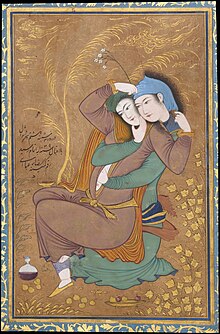Gorgani

Fakhr-od-Dīn As'ad Gorgānī , Persian فخر الدين اسعد گرگانى, DMG Faḫr ad-Dīn As'ad-e Gorgānī (* in Malayer ; † probably 1054) was a Persian poet who lived under the rule of the Seljuq sultan Tughrul Beg .
plant
The only work passed down by Gorgānī is Wīs and Rāmīn , a courtly epic that he wrote between 1050 and 1055. He was inspired by an old legend written in Pahlavi , which goes back to the epoch of the Parthian kings .
Wīs and Rāmīn
In the legend, the king of kings Maubad ( English: Mobad (Mobād) ) receives the promise from Queen Chahrou ( English: Shāhru ), should she give birth to a daughter, to give her to him as a wife. After the daughter Wīs, who was born then, grew up, the queen - forgetting her promise - married her to her own brother Virou ( English: Wīru ). As a result, Mobād Wīru declares war, kidnaps Wīs with the help of a ruse and takes her to Khorāsān . On the way there, Rāmīn , the youngest brother of Mobād and foster son of Shāhru, who was entrusted with the company of Wīs , develops tenderness towards her and Wīs and Rāmīn escape. After a few adventures that the two lovers have to endure with King Mobād, Mobād declares war on his younger brother, but dies as a result of a hunting accident. Rāmīn succeeds him to the throne and marries Wīs. After the death of his wife, Rāmīn transfers the crown to his son and retires to a fire temple , where he remains until his death.
Meaning of wīs and rāmīn
The epic Wīs and Rāmīn establishes a connection between pre-Islamic and Islamic Iran. It is one of the best works of Persian poetry . The simplicity of vocabulary and expression in no way weaken the expressiveness of the images, the plot and the liveliness of the feelings. It was a model for later love epics, especially for Chosrau and Schirin of Nezāmī .
expenditure
Persian-language editions
- William N. Lees (Ed.): Fahr-ad Din As'ad Gurgani. (ca.11th century). Wīs wa Rāmīn . Reprint of the ed. Calcutta (Persian), 1864-1865. Biblio-Verlag, Osnabrück 1982, ISBN 3-7648-1350-4
- Mojtabā Minovi (Ed.): Wīs o Rāmīn . Tehran 1936
- MG Mahjoub (Ed.): Wīs o Rāmīn . Tehran 1959
- Fahr-ad Dīn As'ad Gorgānī: Wīs o Rāmīn (11th century) . In: Zabān wa Adabyyāt-e Fārsi , No. 18, Tehran 1970
German-language editions
- Ruth Neukomm and Kita Tschenkéli: Wisramiani or The Story of Love by Wīs and Rāmīn . Transfer from Georgian. Manesse, Zurich 1957 (transfer of the Georgian version from the 13th century)
- Elke Erb (ed.): Wīs and Rāmīn: Novel of a forbidden love in ancient Persia . Reclam, Leipzig 1991, ISBN 3-379-00662-9 (translation of the Georgian version from the 13th century)
French translation of the work (11th century)
- Henry Massé: Wīs et Rāmīn . Paris 1959
Secondary literature
- Sadeq Hedayat : Some comments on Wis and Ramin . 1945.
source
- Zabihollah Safa : Anthologie de la Poésie Persane . Gallimard Unesco. Connaissance de l'Orient , Paris 2003, ISBN 2-07-071168-4 (French, first edition: 1964, UNESCO collection of representative works ).
See also
| personal data | |
|---|---|
| SURNAME | Gorgani |
| ALTERNATIVE NAMES | Fakhr-od-Dīn Ās'ād Gorgānī |
| BRIEF DESCRIPTION | Persian poet |
| DATE OF BIRTH | 10th century or 11th century |
| PLACE OF BIRTH | Gorgan |
| DATE OF DEATH | around 1054 |
